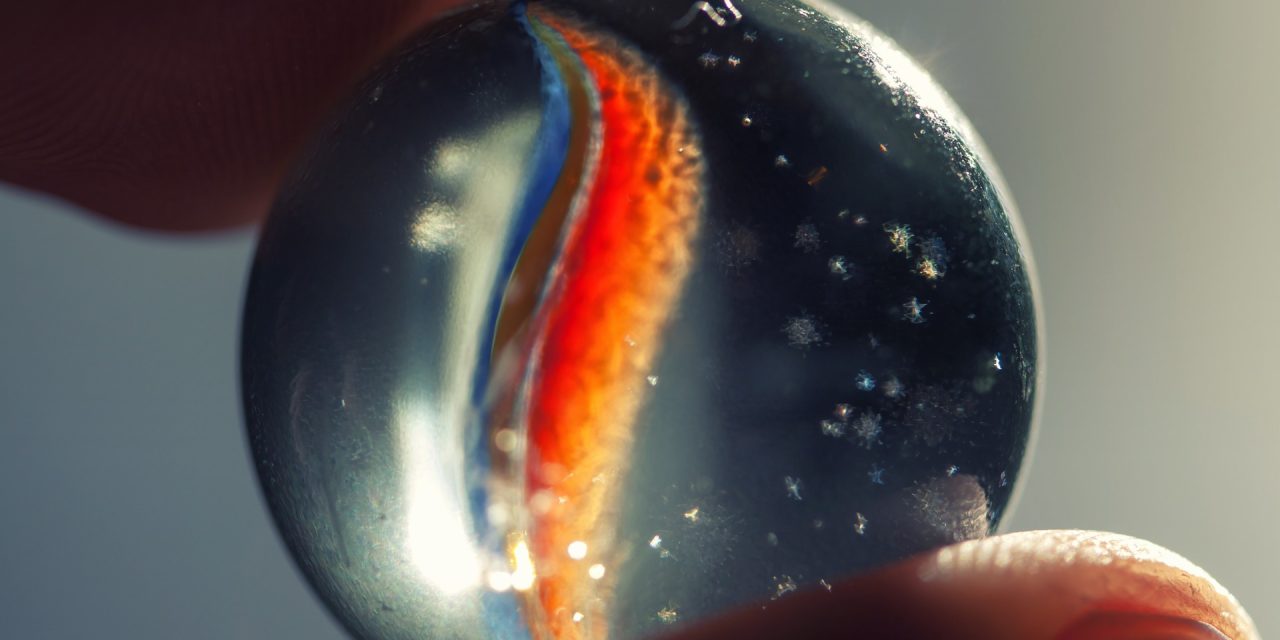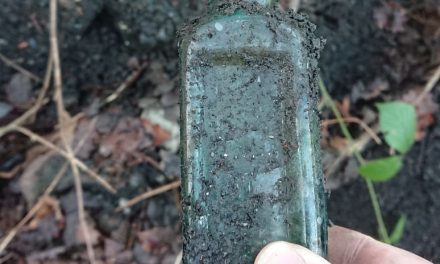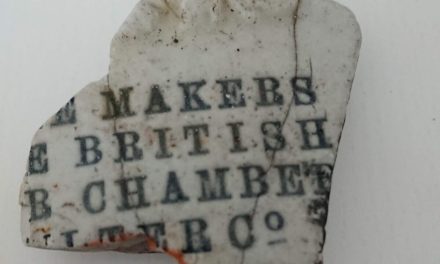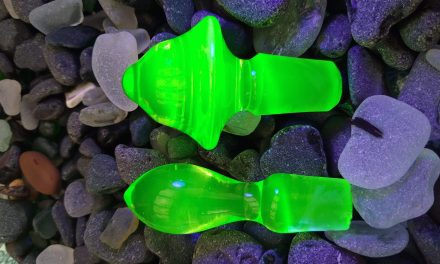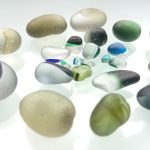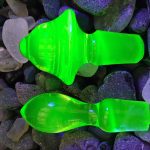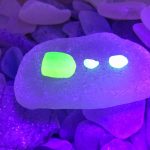People often ask why are there so many marbles on the beach. Mostly, marbles come from coastal rubbish dumps, from aerosol cans, codd bottles, and children’s toys. The first glass marbles were made in 1846, but stone or clay marbles have been documented to have been found from around 2500 BCE. There are many reasons why there are so many marbles on the beach, and in this article, we will give a thorough explanation.
What to expect from our article
Marbles used for practical purposes
Codd marbles – cod marbles are often found on the beach from bottles that were discarded into the sea or from coastal rubbish dumps. These marbles come from bottles called “codd” bottles, where the marble was used as a stopper.
A codd bottle is a type of bottle that was used for carbonated drinks. The design of a codd bottle was based on a glass marble that is held against a rubber seal and sits within a recess in the lip of the bottle. This type of bottle is still used in India; modern-day codd bottles are used in Japan.
Codd bottles came in various colours, and so did the marbles inside them. Codd marbles are usually a solid round piece of glass with no interior colours or patterns. The most popular colour is aqua, but you can also find green, teal, red, and even blue.
Aerosol spray paint marbles: marbles were every little boy’s friend back in an era where kids played outside, but when those little boys grew up and stopped playing with marbles, manufacturers had to find another use for them. Marbles started to be used inside of aerosol spray paint tins, much like nail varnish. When it was shaken, the marble would mix the paint inside. Coastal rubbish dumps were common back in those days, and over time the tin would erode, leaving the marble behind.
Railway marbles: These marbles were first used between 1885 and 1890. It is said a railroad official wanted a marble that could carry five hundred pounds of weight. Marbles were purchased by the tons in the US; they were used as rollers in freight houses and depots to move heavy cargo.
Two one-inch lathes were laid parallel to one another as tracks, and the marbles were placed between them. Freight was pushed up onto the marble tracks and rolled. These types of marbles will only be found on the beach if they run alongside or near a railway or if they were dumped in coastal rubbish dumps. These kinds of marbles were used for practical purposes, so like the codd marbles, they were not fancy coloured or patterned like the marbles that we used to play with; they were usually green in colour.
Ships’ ballast: This is a popular misconception that has been told and repeated among sea glass enthusiasts. There is actually no credible evidence that marbles were ever used as ship ballast; with all the other cheaper materials they could use, like stone or sand, it really doesn’t make sense to use expensive glass marbles. Just because they weren’t used as ballast doesn’t mean that marbles couldn’t have come from ships.
Back in the day, ships were used to import and export goods. The only way to transport these items to other countries was via ship. There have been an unknown number of shipwrecks over the centuries, and any of them could have been filled with a cargo of marbles, but this is, of course, just a theory.
Seeded marbles: This is a very controversial topic among beachcombers, and many really dislike the idea of seeded marbles. People who go beachcombing call it “seeding” when they throw marbles into the water on purpose so they can find them later.
People who seed sea glass or marbles in the sea do so to recreate the naturally tumbled effect of being tossed around the rocks and sand.
Most seaglass enthusiasts frown upon seeding. It is not seen as genuine sea glass if it is put there intentionally. It’s not just about finding sea glass that excites beachcombers; for many, it’s the fact that every piece they find is a piece of history. Modern glass or marbles just don’t have the same effect as finding something that is 100+ years old.
Toy marbles
Marbles were a popular item used for play purposes, and children from all over the world used to play with them. They were a game in themselves that you could play with friends, but they were also included in other children’s games like Kerplunk and Hungry Hippos. Over time, games would break, or pieces would be lost, and they would be thrown away. Just like everything else, they went to the local dump.
Why do marbles end up on the beach or river?
Marbles were a popular toy that was regularly played with outdoors. If you played with marbles as a child, you would know that the games you played required you to throw the marbles. I can’t imagine any parents allowing these games to be played indoors, especially as they could break valuable household items. While playing with them outside, marbles could easily get lost down drains and end up at the beach.
The most likely way that marbles are found at the beach is from coastal rubbish dumps. People back in those days didn’t have a weekly refuse service like we do today, and because of this, they had no way of getting rid of their rubbish.
Rubbish was discarded in all kinds of places, usually on the outskirts of towns, and if that meant throwing it into or near rivers and beaches, then so be it. You have to remember, we are in a totally different era these days where everything is made of plastic that doesn’t break down, but back then, everything was made of glass or pottery. They were most likely unaware of the environmental impact of their rubbish disposal.
Most of the rubbish from those times has broken down and become a part of the beach. In some places, it’s hidden, waiting to be discovered. Take the beach at Lyme Regis; there is an old coastal dump right on the beach. The dump didn’t always used to be that close to the beach, but unfortunately, cliff erosion naturally occurs. When the cliffs fall, things that had been dumped there before are found, including marbles.
History of marbles
It is unknown when the first clay marbles were first produced, but small balls of stone from about 2500 BCE were identified as marbles by archaeologists. The marbles were found during an excavation near Mohenjo-Daro. These marbles were commonly made of clay or stone. Marbles were imported into Britain during the mediaeval era. Records show that in 1503, the town council of Nuremberg, Germany, limited the playing of marble games to a meadow outside of the town.
It is unknown when glass marbles were first manufactured, but we know that a German glassblower invented scissors for making glass marbles in 1846. German marbles were common between 1846 and the early 1900s. Inexpensive ceramic marbles entered mass production in the 1870s. In the 1920s, the US started making marbles with machines. They pretty much took over the marble market, which made Germany export less marbles.
Marbles are made using many techniques that are categorised into two types.
- Hand-made
- Machine-made
Stone or ivory marbles could be made by grinding them. Clay, pottery, ceramic, or porcelain marbles can be made by rolling the material into a ball and either letting them dry naturally or firing them. They could be left natural, painted, or glazed.
Clay marbles, also known as crock marbles or commies (common), are made of slightly porous clay; traditionally, they are made from local clay or leftover earthenware. They are rolled into balls, glazed and fired at a low heat. This created an opaque, imperfect sphere that was frequently sold as the poor boy’s old-timey marble.
Glass marbles could be made using glass rods that were stacked together to form the desired colour and pattern. The rods are then cut into marble-sized pieces using marble scissors. The glass from the cut is then rounded to create a perfectly shaped marble.
Another technique used to make marbles is by dropping chunks of molten glass into a groove made by two interlocking parallel screws. Colour is added to it from other glass rods; these are then combined with the main rod of glass to create the desired effect. As the screws rotate, the marble travels along them, shaping them into spheres as they cool.
Marble nostalgia
There were various types of marbles, and the names of these marbles varied from place to place; when I was little, we referred to marbles as allies. Here are some of the most popular ones.
Aggie: These marbles were made of agate or glass that looked like agate; aggie is short for agate.
Alley: These marbles were made of marble or alabaster; the term alley is short for “alabaster”. They were streaked with wavy and other patterns with exotic names, like
- Corkscrew
- Spiral
- Snake
- Ribbon
- Onyx
- Swirl
- Bumblebee
- Butterfly
Ade: These marbles had a fluorescent-coloured base with opaque white and other coloured strands mixed through; they got their name because they looked like
- Lemon-ade
- Lime-ade
- Orange-ade
- Cherry-ade
Lemonades have yellow added to this base; limeades have green, and so on. The ade marbles were mostly swirled, but sometimes they had distinct corkscrew patterns and even rarer patches.
Cat’s eye: These marbles had a clear glass base and featured a blue, red, white, yellow, or green stripe. Mass-produced marbles had a greenish tint, but true vintage cat’s-eye marbles were clear.
Luz: These were handmade German marbles with a swirl, containing bands of fine copper flakes that glittered like gold. They were thought to have been invented by glassmaker Nicholas Lutz.
Onion Skin: These were handmade German swirl marbles. They have a transparent base or yellow, which is usually clear with many closely packed surface streaks. The marble can have either a coloured core or a clear transparent core. On the core are flecks of colour; the flecks are usually red, blue, or green. Other colours are rare. Some of these marbles had a left-hand twist, which is rare but not as rare as swirls.
Commie or common: These were made of clay; they had a natural or monochrome colouration and were made in huge quantities during the 19th and early 20th centuries. These are the clay marbles that we find on the beaches today. They are also found in old rubbish dumps.
Marble terminology
Knuckle down: This is the position that is taken at the start line at the beginning of a match; the player begins with his or her knuckle against the ground.
Quitsies: Players can opt for quitsies, which allow them to exit the game, or no quitsies, which allow them to remain in the game.
Keepsies, or for keeps: This is where the player keeps all the marbles he or she wins.
Elephant stomps: When elephant stomps are called, it allows a player to stomp on their marble, levelling it with the surface of the ground. Doing so makes it very difficult for other players to hit it.
Bombies: When called, it allows a player to take one or two steps while holding his or her marble. While closing one eye, they can line up over one of the other opponent’s marbles and drop their marble while trying to hit the marble on the ground.
Leaning tops: This is when a shooter leans in on his or her non-playing hand to gain leverage over an indentation on any type of surface or obstacle.
Marble sizes
A taw, or shooter, is a larger marble than most other marbles; you use it to shoot with. A grandfather is the largest marble and is the size of a billiard or tennis ball.
Various names are used to refer to the size of a marble. Any marble that is larger than other marbles can be referred to as;
- Biggie
- Boulder
- Bumboozer
- Bonker
- Bumbo
- Bowler
- Cosher
- Crock
- Dobber
- Dobbert
- Fourer
- Giant
- Goom
- Godfather
- Hogger
- Masher
- Noogie
- Plumper
- Popper
- Shooter
- Smasher
- Thumper
- Taw
- Tonk
- Tronk
- Tom Bowler
- Toebreaker
Ducks are marbles that you shoot at, and a marble that is smaller than all regular marbles is called a mini, peawee, or peewee. Wouldn’t it be fun to bring back the game of marbles to get kids outdoors again and off those gaming consoles?

